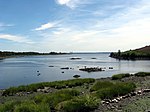City Island Bridge
Bike paths in New York CityBridges completed in 1901Bridges in the BronxCity Island, BronxPedestrian bridges in New York City ... and 6 more
Pelham Bay ParkRoad bridges in New York CitySteel bridges in the United StatesSwing bridges in the United StatesUse American English from October 2017Use mdy dates from October 2017

The City Island Bridge is a bridge in the New York City borough of the Bronx, connecting City Island with Rodman's Neck on the mainland. The original bridge, which carried vehicles from 1901 to 2015, was replaced by the current bridge (also called the City Island Causeway), which opened in 2017. A temporary bridge was used for the demolition and construction period between the original and new bridges.
Excerpt from the Wikipedia article City Island Bridge (License: CC BY-SA 3.0, Authors, Images).City Island Bridge
City Island Bridge, New York The Bronx
Geographical coordinates (GPS) Address External links Nearby Places Show on map
Geographical coordinates (GPS)
| Latitude | Longitude |
|---|---|
| N 40.856257 ° | E -73.793291 ° |
Address
City Island Bridge
City Island Bridge
10464 New York, The Bronx
New York, United States
Open on Google Maps









